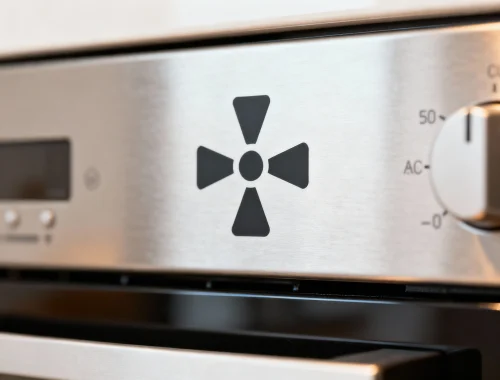
Oven Cleaning Symbols (All Major Brands): Your Easy Guide to a Spotless Oven
Ovens are magical machines in our kitchens. They bake, roast, and cook meals that bring families together every day. But one thing many people dread is keeping them clean. Have you ever stared at your oven’s control panel, confused by tiny symbols? I sure have! The symbols seem like secret codes—especially the ones related to cleaning.
Over time, I learned how to read those symbols and use the oven’s cleaning features correctly. Now, I want to share everything I know so you can keep your oven sparkling without guesswork or harsh chemicals. Whether you have a Samsung, Bosch, Whirlpool, or another popular brand, this guide will unlock the mystery of oven cleaning symbols for you.
Table of Contents
ToggleWhat Is the Symbol for a Clean Oven?
Let’s start with the most important symbol—the one that means your oven can clean itself with little effort from you.
The self-cleaning oven symbol most often looks like a small flame or a circle with wavy lines inside it. Sometimes it is a square with dots or a half circle with dots representing heat and cleaning power.
For example:
-
On some brands, a small flame inside a circle means the self-clean feature.
-
Other ovens show a square with dotted lines inside, suggesting the self-clean cycle is ready.
When you see this symbol, it means the oven will heat to a very high temperature, burning off leftover food and turning it into ash you can easily wipe away.
What Are the Different Symbols on the Oven?
Oven doors and control panels can seem like a puzzle game with various symbols. Here are some cleaning and cooking icons you are likely to see and what they mean:
-
Fan with heat waves: This means the fan is on while heating. It helps cook food evenly and dries the oven during cleaning.
-
Square with lines above and below: This shows the top and bottom heating elements working together.
-
Circle in the middle: This indicates the main heating element is active.
-
Lock symbol: This shows the oven door is locked—often during self-cleaning for safety.
-
Droplet or water drop: Signals steam cleaning or a need to add water for steam programs.
-
Brush or broom icon: Sometimes this represents a manual cleaning reminder or mode.
Common Cooking Symbols
-
Fan symbol → convection cooking.
-
Snowflake → defrost mode.
-
Grill lines → grilling or broiling.
-
Dish with steam lines → reheat or keep warm.
Common Cleaning Symbols
-
Spray or drops → steam clean.
-
Lock with heat waves → pyrolytic clean.
-
Dots or shaded walls → catalytic liners.
I remember the first time I saw these symbols on my new oven and felt lost. Thankfully, the manual helped, but this guide saves you flipping pages!
What Is the Self-Cleaning Oven Symbol?
Self-cleaning ovens are a blessing—they do most of the scrubbing for you. The self-cleaning symbol is usually something that looks like a flame or a small oven with heat waves inside.
Major brands use different icons, but they all mean the oven will:
-
Lock the door for safety.
-
Heat to very high temperatures (often 900°F or about 480°C).
-
Ash leftover food so you can wipe it away easily once the oven cools.
Here are how some popular brands represent the self-cleaning symbol:
-
Samsung: A flame inside a circle.
-
Whirlpool: A padlock with heat waves or a flame icon.
-
Bosch: A square with dots and a circle or a small fire symbol.
-
GE: A flame symbol or an oven with waves inside.
-
Pyrolytic Self-Cleaning
-
Symbol: Lock + heat waves.
-
Function: Heats oven to extreme temperatures, turning residue into ash.
-
Tip: Always remove trays and racks before starting.
-
-
Steam (Hydrolytic) Self-Cleaning
-
Symbol: Water droplet or dish with steam lines.
-
Function: Uses steam to soften grease.
-
Tip: Good for light cleaning, not heavy build-up.
-
-
Catalytic Self-Cleaning
-
Symbol: Often no active button—oven walls are lined with catalytic panels.
-
Function: Grease burns off while cooking at high temperatures.
-
Tip: Panels may need replacing after years of use.
-
If your oven looks different, check the user manual—it usually matches these patterns.
Which Oven Settings to Use?
Knowing which oven settings to use makes cleaning easier and more effective. Let’s look at common settings and when to use them:
1. Self-Cleaning Mode
This is the go-to for tough, baked-on messes. It heats the oven to melt grease and burn food remains. Use this mode:
-
When your oven is very dirty.
-
Make sure to remove racks unless your manual says they are safe to clean inside.
-
Ventilate your kitchen well, since it can produce smoke and odors.
2. Steam Cleaning Mode
Some ovens have a gentle steam cleaning option. It uses water and heat to soften grime. Use this mode:
-
For light cleaning.
-
When you want to avoid the high heat of self-cleaning.
-
You may need to add water to a tank or compartment first.
3. Manual Cleaning Reminder
Some ovens remind you to clean with a brush or wipe. This symbol is a prompt, not a mode. Don’t ignore it—it helps keep your oven fresh.
4. Regular Baking or Roasting Settings
These don’t clean well, but using proper settings (like convection bake) can reduce grease build-up by cooking food evenly.
Unique Tips and Insights From My Kitchen Experience
-
Don’t wait too long to clean. After my first self-clean, I left my oven dirty for months—the high heat later made the debris stick harder! Cleaning moderately and regularly saves effort.
-
Racks need special care. Most self-cleaning cycles can damage or discolor racks. Remove and wash them by hand with warm soapy water.
-
Ventilate well. High heat can cause smoke or odors to fill your kitchen. I always open windows and run an exhaust fan.
-
Use protective gloves. Your oven will be hot after cleaning; protect your hands during ash removal.
-
Try natural cleansers for manual scrubs. Baking soda and water paste works wonders for spots the oven cycle missed.
Why Understanding These Symbols Is Good Now
New ovens come with many features to help clean with less effort. However, many people don’t use these features properly because they don’t understand the symbols. Also, there are many brands now competing by adding unique cleaning features, leading to more confusing icons.
Knowing what these symbols mean:
-
Saves time and effort.
-
Prevents damage to your oven.
-
Keeps your kitchen safer.
Since few quality guides explain this clearly, this article helps solve a widespread problem with simple words any user can understand.
Oven Cleaning Symbols by Major Brands
Each brand uses slightly different icons. Let’s go through the popular ones.
Bosch
-
Pyrolytic symbol: A lock with three vertical lines.
-
EcoClean symbol: Shaded oven walls (represents catalytic liners).
-
Steam clean: A small water droplet.
Whirlpool
-
AquaClean: Pan with water at the bottom.
-
Self-clean: Heat waves + lock.
-
Grill cleaning: Zigzag grill icon with sparkle.
Samsung
-
Steam Clean: Water droplet with steam lines.
-
Self Clean: Lock with flame-like waves.
-
Eco symbol: Leaf icon for energy-saving.
Electrolux
-
Pyrolytic: Square with three lines inside.
-
Steam clean: Dish symbol with steam waves.
-
Catalytic liners: Dotted walls.
LG
-
EasyClean: Water droplet with sparkle.
-
Self Clean: Lock symbol.
-
Fan-assisted cleaning: Fan with waves.
Quick Tip: If you’re ever unsure, most ovens allow you to press and hold the button for a few seconds to see a description on the digital display. I only discovered this after months of guessing!
Unique Insights You Won’t Find in Manuals
-
Not all self-cleaning modes are equal. Steam is best for frequent upkeep, while pyrolytic is a “reset button” for deep cleaning.
-
Cleaning smells differ. Pyrolytic cleaning can smell smoky. Always ventilate your kitchen. Steam cleaning has almost no odor.
-
Energy matters. Pyrolytic cleaning uses a lot of power. Doing it in cooler months actually helps warm your kitchen.
-
Don’t ignore the racks. Self-cleaning modes usually don’t cover trays and racks. I soak mine in hot soapy water during the cycle.
-
Symbols may overlap. Some brands use one droplet symbol for both steaming food and steam cleaning. The context (clean vs cook) matters.
Common Mistakes People Make
-
Leaving racks inside during pyrolytic cleaning.
This warps and discolors them. Always remove. -
Using harsh chemicals before running a self-clean.
This can damage oven surfaces and release toxic fumes. -
Ignoring safety lock.
Pyrolytic ovens lock for a reason—never try to force it open. -
Not cleaning regularly.
Waiting too long between cleans makes even the best symbols useless.
Personal Fail: Once I ignored cleaning for months and had to run two pyrolytic cycles back-to-back. The smell lingered for days. Lesson: light, regular cleaning saves effort.
How to Remember Oven Cleaning Symbols Easily
Here’s a trick I use:
-
Droplet = Steam.
-
Lock = High heat (Pyrolytic).
-
Dots = Catalytic liners.
-
Pan with water = Aqua clean.
Writing these on a sticky note and keeping it on the fridge helped me until I memorized them.
Final Thoughts
Oven cleaning symbols might seem tricky, but they simply guide you to make your oven maintenance easy and effective. Whether you’re running a self-clean cycle or scrubbing manually, knowing what buttons and icons mean is the first step to a sparkling kitchen.
Next time you look at your oven panel, imagine it as a helpful friend guiding you—not a secret code to crack. Clean ovens mean better cooking results and longer oven life. And that’s a recipe for happy meals every day!
You May Also Like

Best Energy-Saving Home Heaters 2025
August 19, 2025
Elevated Indoor Planters: The Secret to Stylish Plant Displays
May 12, 2025

